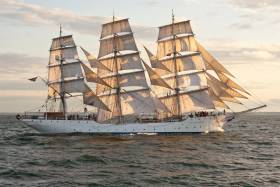Displaying items by tag: Norwegian tallship
Fully Rigged Norwegian Tallship Anchors in Cork Harbour
#Tallship - A Norwegian tallship classified as a fully rigged ship which is to celebrate its 80th anniversary next year is at anchorage in Cork Harbour today, writes Jehan Ashmore.
Christian Radich will be marking the 80th anniversary by making special commemorative voyages along the spectacular Norwegian coast.
In the meantime her visit to Cork Harbour follows sailing in UK waters and having set off almost a fortnight ago from her homeport of Oslo. She is anchored in the lower Cork Harbour between Cobh and Whitegate and is to remain until a departure tomorrow morning.
Another Norwegian tallship which is even older having been built more than a century ago in 1914 is Statsraad Lehmkuhl, which made a visit to Dublin as part of National Heritage Week in August.
The pair serve as ambassadors of the Nordic state, which has a very strong maritime tradition, notably in the energy and exploration sectors.
Operated by an Oslo based foundation, the 1937 built Christian Radich, has been preserved for future generations as primarily serving as a school ship. Setting a sail area of 1360,00 m2, the trainee ship is used for voyages for 15 trainees of all ages and is available for charter.
The services of the tallship were also used by the Norwegian Navy’s officer school, however they were unable to renew the contract with Christian Radich after April 2015, despite it been a successful collaboration.
Other clients in the form of Norwegian maritime college students have taken up sail training from September to May. It is during this current winter programme that Christian Radich is offering a week's voyage around the Canary Islands beginning next year in early January.
Looking further ahead in April, there are places for those who want to compete in a race as the Christain Radich enters the first leg in the rendez-vous of the 2017 Tall Ships Regatta. This is to take place in Greenwich, downriver of central London before heading to Canada.






























































